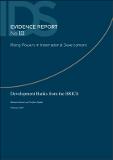| dc.contributor.author | Barone, B | |
| dc.contributor.author | Spratt, Stephen | |
| dc.coverage.spatial | Brazil | en |
| dc.coverage.spatial | Russia | en |
| dc.coverage.spatial | India | en |
| dc.coverage.spatial | China | en |
| dc.coverage.spatial | South Africa | en |
| dc.date.accessioned | 2015-02-13T10:42:38Z | |
| dc.date.available | 2015-02-13T10:42:38Z | |
| dc.date.issued | 2015-02 | |
| dc.identifier.citation | Barone, B. and Spratt, S. (2015) Development Banks from the BRICS, IDS Evidence Report 111, Brighton: IDS | en |
| dc.identifier.uri | https://opendocs.ids.ac.uk/opendocs/handle/20.500.12413/5781 | |
| dc.description.abstract | The BRIC acronym was created at the beginning of the 2000s to represent a group of four
fast-growing economies – Brazil, Russia, India and China – and was changed to BRICS in
December 2010 with the inclusion of South Africa. At its fifth annual summit in Durban at the end of March 2013, the group announced the future establishment of a New Development Bank (NDB) to meet infrastructure investment needs in the developing world. At their sixth annual summit in Fortaleza the following year (July 2014), the BRICS finally agreed on the broader arrangements for the bank – an initial US$50bn fund – and coupled this achievement with the launch of the Contingency Reserve Arrangement (CRA) – US$100bn to be accessed to alleviate members’ financial difficulties (US$41bn from China, US$5bn from South Africa and US$18bn from each of the others). The Bank will start lending in 2016. Despite this achievement, commentators estimate that even if the NDB eventually increases its capital to US$100bn with injections from non-BRICS states and institutions (up to a maximum capital share from non-BRICS countries of 45 per cent), most infrastructure needs in the developing world will remain unmet. Compared to the World Bank and Asian Development Bank – whose subscribed capital is US$223bn and US$162bn respectively – the additional capital available from the NDB is too small to fill the financing gap (Spratt 2014). According to World Bank estimates, South Asia alone requires US$2.5tn over the next ten years, while overall the BRICS states are estimated to need a total of more than US$4.5tn over the next five years for infrastructure development. In consideration of the limited amount of lending that the NDB may provide, the bank may create ‘special funds’ – i.e. separately funded and managed mechanisms – designed to get round this capital constraint (Spratt 2014). | en |
| dc.description.sponsorship | UK Department for International Development | en |
| dc.language.iso | en | en |
| dc.publisher | IDS | en |
| dc.relation.ispartofseries | IDS Evidence Report;111 | |
| dc.rights.uri | http://creativecommons.org/licenses/by/3.0/ | en |
| dc.subject | Finance | en |
| dc.title | Development Banks from the BRICS | en |
| dc.type | IDS Evidence Report | en |
| dc.rights.holder | IDS | en |
| dc.identifier.ag | OT/11009/5/1/1/509 | |


